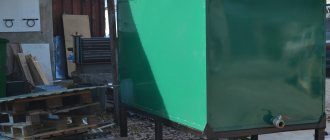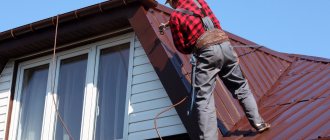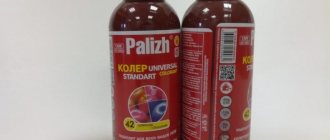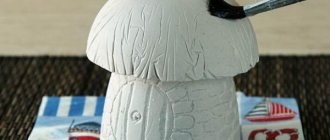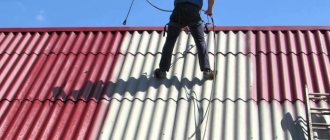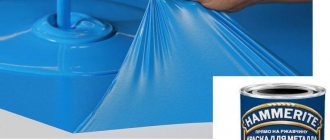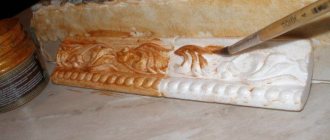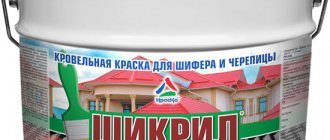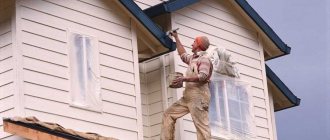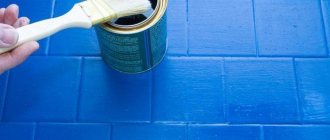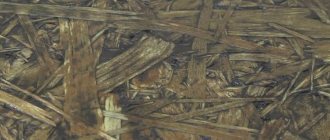Roof paint for rust
Metal roofing materials are always relevant in the construction of residential buildings and outbuildings. The popularity of the coating is explained by its high performance characteristics, long service life and affordable price. The meager choice of color for metal materials can easily be solved by painting with special compounds. Roof paint should not only complement the overall appearance of the house, but also protect the material from weather conditions and corrosion.
Necessary tool
Painting the roof of a house is done using the following tools: brushes, a paint roller and a spray gun. Painting with a brush is labor-intensive and time-consuming. In addition, paint consumption is increased. and the brush may leave lint on the surface. A roller is the golden mean: compared to a brush, the speed is higher, the layer is applied thinner, and paint consumption is less. A spray gun is the ideal option: the highest speed of coating application, minimizing consumption. True, there is a drawback to using it; if you choose rubber paint, it is difficult to apply in its pure form with a spray bottle. However, there is a way out: just add a thinner, only the one recommended by the rubber paint manufacturer. Another advantage of spraying paint is uniform color and the ability to control the applied layer and pressure force.
Spray painting
Why do you need roof painting?
Metal roofing is made from galvanized steel coated with a protective oil layer. This impregnation is enough for about 10-12 months of operation, after which it is washed out under the influence of precipitation and ultraviolet radiation. Therefore, to properly protect the metal from adverse environmental conditions, the roof must be coated with paint. This processing allows:
- prevent rust and subsequent destruction;
- improve the aesthetic qualities of the roof;
- reduce subsequent costs for repairs or replacements.
It is recommended to paint the roof immediately after installation (weather permitting).
Types of roof paint
Roof paint is selected primarily taking into account technical characteristics, such as resistance to rust, temperature changes and precipitation. For the production of roofing materials, ferrous and galvanized metal is used. Therefore, paintwork materials for such work are produced from different materials. Depending on the type of composition, roofing protective compounds are:
Painting with an oil composition is the cheapest. However, such a coating cannot be called practical: it will have to be updated frequently, which will lead to new expenses.
Acrylic primer paints are considered one of the best solutions for protection against rust. The coating has a high cost, which is fully justified by its long service life. In addition, a roof coated with such a composition looks very aesthetically pleasing, which cannot be said about a roof coated with oil.
Oil paints
Oil paints and varnishes were often used in the past, and some craftsmen still use them today. However, treating metal with such a composition does not provide adequate protection. After application, the coating looks very aesthetically pleasing, but after a few months the paint will begin to fade and crack. Such manifestations are associated with low elasticity of the coating. However, as a temporary option, the treatment is not bad. A coating made of such material will have to be renewed every 1-2 years.
Alkyd paints
Such compositions are slightly more expensive than oil-based ones, but at the same time they provide the metal with better protection. Alkyd treatments have a wide range of colors, but the coating pigments are not very resistant to ultraviolet radiation. If you want to maintain the rich color of your roof, you need to apply a new coat every 2-3 years. Such compositions also have low elasticity. This disadvantage is especially evident during temperature changes.
Acrylic paints
A decade ago, such compositions were not durable. However, in the last few years, compositions have gained popularity among both professionals and private craftsmen. The wide distribution of paints is explained by their advantages:
- UV resistance provides pigments with durability for many years;
- the material contains anti-corrosion inclusions, which ensures resistance to precipitation and rust;
- aesthetic appearance of the finished coating.
Acrylic paint can last up to 10 years; this is the period after which professionals recommend renewing the coating.
Advantages of an ondulin roof
The popularity of using ondulin is explained by a number of its characteristics:
- Light weight. A sheet of material weighs only 6 kilograms, which makes it lighter compared to other types of roofing products, so installation requires a simple rafter frame and sheathing. The weight of ondulin makes it possible to lay a new coating without dismantling the old one.
- Strength. This property is due to the presence of a fibrous structure in the material. Ondulin is able to withstand a snow load of 300 kg/m².
- Waterproof and low water absorption. The material is resistant to water. It does not absorb moisture due to the presence of bitumen impregnation.
- Long service life. Ondulin is able to withstand 25 cycles, during which it is first frozen and then thawed, without changing its structure or losing its original properties. According to the manufacturer's warranty, the service life reaches 15 years. If the coating is properly cared for, it will last at least 30-40 years.
- Resistance to microorganisms. As you know, ondulin is impregnated with petroleum bitumen, which is a powerful antiseptic and for this reason a roof with such a coating cannot be damaged by fungus and mold.
- Environmental Safety. The components used for the production of ondulin do not negatively affect human health or the environment, and this circumstance distinguishes it from other roofing products that may contain harmful impurities.
Rubber acrylic paint
One of the varieties of acrylic paints is rubber. The composition is made from environmentally friendly materials. It is absolutely harmless to humans and animals. The substance can be diluted with water to obtain optimal density. One of the main advantages of the composition is its flexible, breathable structure, which allows the coating to maintain its integrity after temperature changes and heavy precipitation.
In order for the coating layer to remain undamaged for many years, it is necessary to choose the right coloring composition. Acrylic rubber paints differ in the type of material on which they should be applied. Painting compositions available:
- slate;
- wood;
- bitumen roll materials;
- metal tiles;
- galvanized sheets.
The paint is chosen depending on the roofing material. You should not buy a compound to work on another surface. The composition is developed based on the structure and specifics of the working surface. So, metal coatings contain more anti-corrosion components, and materials for wood contain substances against pests and rot. Properly selected coatings will protect the roof from bad weather and ultraviolet radiation and allow you to save money.
Rubber paints have high adhesion. They can be classified as deep penetration paints. After application, they form a durable flexible film on the surface that does not delaminate over time. The substance has a water-repellent layer that protects the metal from precipitation, sun and other negative phenomena. The main advantages of the composition are the following characteristics:
- long service life (about 10 years);
- increased waterproofing;
- high level of adhesion to the working surface;
- maintaining technical indicators even with large temperature differences;
- resistance to mechanical damage;
- rich color palette.
Among other things, the composition does not crack over time, which cannot be said about alkyd and oil compositions.
Types of paint
The main requirement for roofing paint is resistance to weather conditions. These include:
- temperature effects
- sudden weather changes
- ultraviolet
- ability to withstand base deformation. For example, a metal roof expands when heated, and therefore the paint should also expand along with the roofing. If this does not happen, then small cracks will appear on the roof and the result will only upset the owner of the house.
Spray painting reduces paint consumption
In addition to the expansion function, there is an important requirement for appearance. To do this, special compounds are included in the paint composition, which affect the uniformity of application, uniformity of color and resistance to fading. Many types of roofing paints differ in the above points.
Oil paints
Time-tested oil paint is well suited for metal roofs, low price, but susceptible to atmospheric phenomena. The paint composition does not contain substances that promote elasticity and, as a result, the roof becomes covered with cracks and the slopes have to be repainted after 3-5 years. Therefore, this paint can be used for summerhouses, which will not be difficult to repaint.
Alkyd paints
So-called alkyd paints are an improved version of oil paints. Alkyd paints have the same curing mechanism as oil paints. However, alcohols and vegetable oils are already used here. For those roofs that have damage, alkyd rust paints with zinc particles are suitable. The alkyd-urethane mixture prevents deep corrosion and does not allow it to spread further. The downside is that it is not fade resistant. And although there is no need to remove rust, this reduces labor costs. However, it must be taken into account that the rust on the sheets must be fresh, and it is better to replace severely affected sheets.
How to choose a beautiful and high-quality roof
Acrylic paints
Acrylic paint is of higher quality. High degree of elasticity and adhesion to any surface, UV resistance. The paint is suitable for metal and slate roofs. The service life of the coating is approximately 25 years! What is important is that you yourself can add certain components to the composition in order to achieve the desired technical properties.
Comparison of arkyl roof paints
For example, anti-corrosion acrylic paint. It contains a substance that prevents rust from forming. Therefore, this paint is not suitable for slate roofs. When installing a metal roof, you need to treat the entire roof before the first rain, then the service life will increase by tens of years.
Roofing paints for rust
Rubber paints
This is the thickest paint, resembling polymer mastic for self-leveling floors. However, after application to the roof it hardens. This creates a very strong and elastic film. The latter is capable of stretching, which is very unusual for us. It is noteworthy that this paint has nothing to do with rubber. The name comes from its high elasticity. The composition includes: latex (provides plasticity), coalescent (serves to form a film on the surface), antifreeze (frost resistance), water as a binding element, preservative (protection from mold and mildew) and also fungicides and pigments.
Rubber paint
Rubber paint belongs to the acrylic group and is suitable for slate and metal roofs. The advantage is such positive characteristics as heat resistance, absolute waterproofness, lack of toxic odor, and safety for health. In the store you can buy such paint not only for the roof, but also for the base and facade. Moreover, each of them has its own unique characteristics.
Almost all manufacturers produce the appropriate primer for their paints; in the store you can find paint kits, the set includes both paint and primer with similar characteristics to achieve the best effect.
Preparatory work
If the roof is being painted for the first time, it is enough to remove dust from it. Old roofs must be cleaned of paint and rust using a wire brush or chemical rust removers. The sheets eaten away by rust are replaced with new ones. When preparing the roof for painting, it is necessary to check the gutters and other adjacent structures and communications, especially from the attic. The calculation of the substance depends on the roof area. The average coating consumption is indicated on the packaging.
Subsequent work depends on the type of processing selected. Any composition must be thoroughly mixed before application. First, gutters and slopes are painted. For stingrays, use a wide brush or roller. The roof is painted from top to bottom, then the ridge is painted.
Roof with galvanized metal roofing
If the roof of the house is covered with galvanized sheet, then there is its own technology and materials for painting it.
Preparing the roof of a building for painting
So, preparing such a roof consists of removing all debris from its surface, old paint layer, rust, and so on.
To do this you will need a special metal brush. It is most convenient for getting rid of rust and some debris. Special chemical compounds are also used for these purposes. Among such compositions there may be WD-40 liquid, known to all motorists. It copes well with rust deposits and many greasy stains. To protect the roof of a house from rust, it should be treated with an anti-corrosion compound.
Roof painting
Metal roofs can be covered with so-called ferrous metal and galvanized metal.
Coloring Tips
Regardless of the paint chosen, the following recommendations should be followed when carrying out work:
- paint the roof not in the heat, but in warm weather of 10-25 degrees;
- do not apply the coating under the sun;
- do not treat the surface in the rain, the paint will form drops and bubbles, and will peel off when dry;
- for dilution, use the thinner recommended by the manufacturer;
- wait for the first layer to dry before applying the second (this will extend the life of the paintwork);
- Do not apply the paint thickly, this will avoid smudges.
Related article: Which corrugated sheeting is better for the roof of a house
Rubber acrylic paints allow you to give the roof a semi-matte, rough surface. A wide variety of colors will allow you to choose a shade that matches the style of the building. After treating the roof with a rubber coating, a durable layer is formed on it, protecting it from bad weather, pests and fungus. The coating is optimal for painting old roofs. If you need roof paint to combat rust, use acrylic compounds. Alkyd and oil-based paints are good for new roofs, but remember that coatings made from this composition will not last long.
Suitable weather conditions
Painting the roof of a house requires following a certain order of work. Before starting the painting process, the paint should be thoroughly mixed to avoid separation. Air humidity should ideally be no higher than 80%. On a hot day, it is better to postpone painting, because the metal can heat up to 100 degrees, especially in direct sunlight, and the solvent will dry out very quickly, which will lead to poor adhesion. It is best to paint slate and galvanized roofs within the temperature range specified by the manufacturer. Then the dye will apply easily and evenly. Some paint manufacturers recommend working at temperatures from +1 degrees Celsius, others from +10, and still others even in the cold season. But it is still better to work optimally at air temperatures from +10 to +25 degrees. It is important to stop all painting work before the evening dew falls. Because matting of the surface may occur.
How to Paint a Metal Roof on a House
To ensure that a metal roof lasts as long as possible, it is periodically painted. This allows you to constantly maintain the protective layer of the metal surface in good condition, which will protect the coating from negative external influences. In addition, regular painting will ensure that both the roof and the entire house look consistently good. Before you start painting your roof, consider the following tips:
1. Only dry weather is suitable for painting the roof, otherwise the quality of the coating will be poor and the operation will need to be repeated quickly.
2. Hot weather is also not very favorable for painting, because at high temperatures the paint material does not dry properly. The best season for roof restoration is autumn and spring, when it is not very hot.
3. When working on the roof, it is important to take safety precautions and ensure that you have fall insurance. Shoes with rubber soles are most suitable for such activities, because they do not slip on a metal surface.
If all the necessary conditions are met, then you can proceed directly to painting using the following technology:
• First of all, the roof is inspected: it is important to detect all defects, damage and cracks. Areas damaged by corrosion should be thoroughly cleaned with a wire brush.
• The entire roof base is coated with an anti-corrosion primer.
• To seal small cracks and damage, use a special putty paste (you can prepare it yourself from dry chalk and drying oil). In order for the sealing areas to stand out when painting, a little roofing paint is added to the paste for tinting.
• To eliminate larger damages, they resort to the patch method. They are cut out of tarpaulin, soaking it in drying oil and red lead. After the patch is well saturated, it is applied to the damaged area.
• Also, before painting, you should inspect all roofing ridges and joints, if necessary, tapping them with a mallet to compact them. • The primer solution is prepared by diluting the paint with drying oil and applied in a thin layer over the entire roof area.
• After the primer layer has dried, you can begin the main painting, and a terry brush with stiff bristles is best suited for this, since it is much more convenient to rub the substance into the roof surface than with the same roller.
• It is recommended to paint the roof slopes first, since the material consumption in these areas is the greatest. After this, the rest of the roof is painted. It is most convenient to apply paint to a brush in small portions, spreading it well over the metal roof. To maintain the uniformity of the paint material, it must be stirred periodically.
• The number of paint layers depends on the degree of wear of the roof. If it was installed recently, the paint is applied in 2-3 layers, pausing between paintings for at least 5 days.
• It should be taken into account that the inside of a metal roof also needs painting, the coating of which is usually limited to two layers.
• The type of coloring agent is selected in the store, depending on the type of metal roof.
Preparing metal before painting
Regardless of the type and quality of paint, the metal surface must be properly and efficiently prepared; the result of your work almost entirely depends on this. To prepare a surface means to clean it of everything that has accumulated on it.
First, remove debris from the surface. Then you need to remove the rust and old peeling paint; you can use a scraper, wire brush, emery, or even a regular metal dishwashing sponge for this purpose.
Wash away stubborn dust, dirt, oil, grease, salts, etc. But do not use abrasive products; it is better to use a regular soap solution. Then rinse the surface with clean water and let dry.
If a massive product is intended for painting, then you can use an oxygen-acetylene torch. The paint will burn from the burner flame, and scale and rust will peel off due to corrosion products and the difference in the thermal expansion coefficients of the metals.
In advanced cases, you can use a rust converter. This is a solution made on the basis of phosphoric acid. The product is lubricated with the solution, left for some time, but not less than 3 hours, and then washed with water and dried.
In cases where the rust is completely impossible to remove, be sure to use paint with anti-corrosion additives and apply it directly to the surface that you managed to obtain.
Subtleties of painting the roof of a house
In the painting craft, there are various subtleties and secrets of professional skill that allow you to quickly and very efficiently complete any job. There are nuances to painting the roof of a house, and some of them are offered for study on this page.
It is important to understand that painting an old roof is an expensive operation, which, in principle, with the proper level of training, can be performed by any home craftsman. If you follow all technological aspects, the result will be excellent. You always need to start painting a roof with your own hands with preliminary preparation. It includes removing rust, sealing cracks, restoring the integrity of the coating, etc.
When to paint the roof
We must always remember that painting the roof of a house should be carried out in accordance with weather conditions.
Before asking yourself the question: how to paint the roof of a building, ask yourself when is the best time to do it. Experts always recommend not to start roof painting work in extreme heat, because this will have a very bad effect on the painting process in the future. During rain or wet weather, you also understand that painting the roof is not recommended. A good time to paint the roofing first is spring (either April or May), or it is recommended to paint in the fall (September or October). Dry weather during these periods will guarantee a longer service life of the applied paint, the task of which is not only to transform the roof, but also to protect the material from external influences.
Primer and rust protection
Iron roofs. It is known that iron, especially if it is in the open air or in a damp room, is prone to oxidation and the formation of rust, and therefore painting a metal roof is necessary and should be done especially carefully with the best quality oil paint.
Iron sheets, before they are used to cover the roof, must be well cleaned of dirt, debris and dust and then primed on both sides with drying oil or oil paint diluted quite thinly. Any oil paint that covers well can be used as a primer. More often than others, red lead is used, diluted in 3 parts of drying oil.
After being attached to the rafters, the primed sheets are tinted in places damaged during work, and after that they are painted twice with oil paint. For the first painting of a galvanized roof, paint is taken with a large amount of drying oil; a second layer, and in some cases a third layer, is applied over the dried first layer. It is useful to paint gutters and areas adjacent to drainpipes once again, since in these places the paint deteriorates faster from accumulating water with dust and dirt.
Related article: Is it possible to cover the roof in the rain?
The paint for painting a galvanized roof of a house must be thinly abraded; it should dry quickly enough and be hard; Drying oils for diluting paint should also be of good quality.
To protect iron from rust, the best paint is red lead. 16 kg of this red lead is diluted with 28.6 kg of drying oil; for primer, dilute with three parts of drying oil.
To update the color of surfaces painted with red lead, you can paint the iron roof completely with a brighter paint, such as mummy and others.
Of the green paints, verdigris is especially good as it is the most durable and beautiful in color. Medyanka is used for painting country and country buildings. In cities, with few exceptions, green roofs are quite rare. 16 kg of thick copperhead is diluted with 6-7.4 kg of drying oil.
Mineral, zinc and patented greens are also used to paint the roof, as they are cheaper. Graphite, lead and zinc gray are also recommended. 16 kg of these paints are diluted with 6-8 kg of drying oil.
When choosing paint, you need to take into account that dark colors absorb more sunlight compared to light colors and therefore dark colors heat up more, transferring heat to the iron, which, when expanding, can form cracks in the paint layer. In addition, dark colors quickly fade, which is often noticeable on roofs facing south. Thus, it turns out that light colors of paints for roofing are the most convenient and practical.
Choosing time for painting
As for the time, they choose for coloring in the northern provinces from the beginning of May to mid-July; in the middle and southern provinces you can paint until October. You should avoid painting roofs during those months of the year when the nights become cold and damp, because the paint applied in the morning will not have time to dry until the evening, and such painting will be fragile.
In very dry and windy weather, painting must be done carefully, since settled dust, absorbing a lot of liquid paint at the time of applying it and mixing with it, gives a dirty appearance to the painted surface. In extreme heat, you should also avoid painting roofs, because very rapid drying of the paint is detrimental to its strength.
Repainting iron roofs requires careful removal of not only old peeling paint from the surface, but also rust. To do this, they usually use wire brushes, brooms and scrapers. Old paint that has faded but has not yet fallen off does not need to be cleaned off and you can limit yourself to only removing the accumulated dust and dirt. If the old paint is difficult to remove, then you have to resort to annealing with a red-hot iron.
Primer, putty and painting of an old roof
Wooden roofs, like any wooden surface in general, should be painted only after the wood has completely dried and, moreover, in calm, dry weather.
The surface of wooden roofs is almost always porous and uneven, and therefore greedily absorbs drying oil; When painting, primer and putty are of great importance. To obtain a satisfactory result, the roof must be covered 1-2 times with drying oil before painting, and when the primer is completely dry, all cracks are covered with oil putty. Painted areas are painted once with drying oil and then twice after painting.
The roof of a wooden house is painted with drying oil, red lead or oil paint. But for painting a slate roof, it is better to use special facade compositions based on water-based and lime.
The cleaned roof must be covered with drying oil, and when the latter dries, all cracks and cracks must be covered with putty. But the so-called red lead rubber putty turns out to be more convenient for this purpose. Although this putty dries slower than others, it is elastic and adheres tightly to the iron.
When the putty has dried, the roof must be covered with drying oil or liquid paint, and then twice with oil paint of the chosen color. In general, when repainting an old roof, the cost of paint materials is significantly higher than the cost of painting a new roof.
Some features of metal coloring
Every caring owner who is thinking about what and how to paint an iron fence or other structures should know some of the features of this process:
- The best result can be achieved only if iron paint is used;
- Iron is a material that, without proper protective coating, becomes covered with rust in the shortest possible time. Therefore, to finish it, you should use an alkyd primer containing phosphate or chromate. Primers of this type are able to protect the surface of iron much better than others;
- Today, galvanized iron is often used to create roofs, due to the fact that its resistance to corrosion is much higher. Painting the iron will further increase the lifespan of galvanized metal, which will also give the structure a much more attractive appearance;
- The coating created with alkyd paints is much more durable than the finish produced using acrylic or oil paints;
- The instructions included with each paint and varnish material certainly contain information about which surfaces are appropriate to paint with it. Don't forget to read it carefully before starting work.
How to paint the iron roof of a house
Metal roofing is often installed on country houses. In order to protect it from the harmful effects of the external environment and increase its service life, the metal is coated with paint.
But not any paint can be used to paint an iron roof, so it often arises as to which paint and varnish material would be better for painting in order to improve the quality characteristics and improve the appearance of the roof.
Metal Roofing Material Options
A variety of materials can be used to make a metal roof, including galvanized steel, ferrous and non-ferrous metals.
Ferrous metal is a mild steel that can be easily installed on a roof. This material does not contain substances that can protect against corrosion, so such a roof must be painted as soon as possible.
The roof is often covered with galvanized iron. Zinc coating helps protect the roof from external influences for a long time. But it is impossible to carefully install the coating on the roof without violating the integrity of the zinc coating, so after a while such a roof begins to slowly deteriorate as the zinc coating is destroyed. This is why you need to paint the roof after installing the roof after some time, usually 2–3 months. During this time, the zinc will have time to create a kind of film on the metal surface, which will improve the adhesion of the metal to the paint.
Related article: Design of a hip roof truss system
Roofs made of non-ferrous metals are not very common, but they look just great, and besides, copper is not subject to corrosion. To improve decorative qualities, copper sheets on the roof are specially aged. Under normal conditions, aging occurs after 30 years of use, but with the help of artificial aging you can achieve the desired effect very quickly.
Cost of work
Painting the roof of a house has not only an aesthetic value, but also a practical one. Because it extends the life of the roof, protecting it from corrosion. On average, the price for this work ranges from 40 to 180 rubles. per sq.m. (excluding material). The cost of work depends on the condition of the roof. Since painting a new roof will cost less than one that first requires high-quality cleaning and repair:
- Cleaning from rust, dirt and mold and also removing a layer of old paint, if the roof was previously painted, will cost from 40 to 120 rubles. per sq.m
- Repair work to fill holes, replace rotten sheets from 75 to 2500 rubles. per sq.m
- Washing and degreasing the roof surface: from 35 to 100 rubles. per sq.m
- Surface primer, on average from 35 to 100 rubles. per sq.m
- One coat of paint 40 – 160 rubles. per sq.m
- Painting the roof of a one-story house will be cheaper than a high-rise one
- The angle of the slopes and the shape of the roof also affect the cost of the work.
Approximate prices for painting depending on the type of roof
- Single-pitched, convenient for work, the angle of the slope is 4-6 percent, which makes it possible to work without insurance: 40-80 rubles / sq.m.
- Gables, which have more pronounced two angles of inclination, which leads to less comfortable conditions and increases the cost of work. 50–110 RUR/sq.m
- Hip ones, have 4 slopes, on which work with a safety rope is necessary: 60–120 rub./sq.m.
- Attic, have broken lines, despite the fact that they are gable: 65-140 rubles / sq.m.
- Tents, have many slopes, on which it is extremely difficult to perform actions: 75-160 rub./sq.m.
- Flat, extremely rare: 30-70 rubles/sq.m.
Choosing a paint manufacturer
The cost of the work is also affected by the material from which the roof is made. Slate and tiles will add complexity to the work due to their wave-like shape. You will have to paint with a brush or spray in 2-3 layers. You can save money by choosing a paint manufacturer. Painting material from Russian manufacturers is quite suitable. If you follow all the rules for painting, and, most importantly, preparing the roof for applying paint, the result will please the eye for many years. Here are some examples of the cost of such paints: Polifan (223 rubles/kg), Shikril (223 rubles/kg), VD-AK-121 AC (163 rubles/kg).
How to choose a material for a soft roof
Painting the roof of a house: approximate cost of work depending on the roofing material and
The cost of work with a roof made of corrugated sheets or metal tiles will be slightly higher. The range of cost of work in companies differs and, sometimes, this does not depend on the quality of the service provided. The territorial location of the company and the facility also matters. In small Russian cities, prices are lower than in the capital or St. Petersburg. It is possible to order roof painting on the Internet; to do this, you need to send the company a photo and dimensions of the roof, specialists will provide an estimate, and if everything suits the buyer, then a contract can be concluded. Since most companies provide free estimates. Therefore, you can contact several organizations at the same time and choose the most suitable one. And don’t forget to make sure there is a warranty for painting the roof of your home!
Slate and tiles
Such a roof is painted only for aesthetic reasons. The classic (wavy) shape of slate is difficult to work with, which requires the use of a brush or spray, which increases the cost of the work. To paint slate, it is better to use silicone, acrylic paints or enamels. And it doesn’t matter what the paint base is, and whether they are diluted with organic solvents. The advantages of such paints:
Variety of slate paint colors
- not susceptible to ultraviolet radiation
- the film formed on the surface is more durable
- increased elasticity
- high water-repellent qualities
- retains color.
The main disadvantage is the pungent smell that goes away after the paint dries. But, since the work is carried out in the fresh air, this is not a determining factor. Initially, the roof is primed to close the pores on the surface. For these works, it is better to choose a brush with stiff bristles. A roller is not needed, since it cannot quickly paint over the lower waves.
The work of painting slate must be done carefully, because slate is a fragile material.
Tip: Paint slate that is not yet installed on the roof. Because it is more difficult to work with already nailed slate. Due to the fragility of the material, painting slate should be done very carefully.
Metal roof covering
The price of painting will also depend on the previously described factors and ease of use. The exception is difficult-to-work corrugated sheets or metal tiles, where the cost of work will be higher. Anti-corrosion paint is used for the roof. The method of applying paint of all types is slightly different from each other. It all depends on what is being painted: a new roof or an old roof covered with corroded areas.
Step-by-step video instructions for installing a roof with your own hands: 10 steps
Painting a new roof: First of all, the roof is cleaned, debris is removed and the surface is washed with water. Once the roof is dry, paint can be applied. If the roof is made of ferrous metal, then it is pre-treated with primers, which additionally protect the metal from moisture. The primer is applied in two layers, each of which must dry well. This takes, depending on the air temperature, from 2 to 6 hours. Therefore, plan a day for this stage. If the sheets are galvanized, then no additional processing is needed.
Roof primer
Painting an old roof. The main task is the perfect preparation of the roof for subsequent painting. The detailed scheme of work has the following points:
- Identification of rusty areas of the roof.
- Assessment of the degree of corrosion. (If the damage is severe, repair work is necessary).
- Cleaning rusty areas using an iron brush manually or with a grinder.
- Cleaning the site of subsequent work from debris and dirt. (If necessary, rinse with water and allow to dry).
Regardless of what metal the roof was assembled from, the corrosive areas are covered with a primer in two layers, allowing each layer to dry thoroughly. After a day, paint is applied in two layers.
Galvanized steel and oil layer
When painting a galvanized roof, there is no need to prime it first. This can only be done in places where corrosion has already begun. Compared to other types of roofing, this coating is the most problematic. Because if you choose the wrong paint, it won’t stick. And to prevent the paint from peeling off, you need a composition that contains substances that affect adhesion and elasticity. Preparation for painting includes the following activities:
- removing white rust stains with a steel brush or sanding,
- cleaning accumulated dirt,
- rinsing with clean water.
If you do not do all these labor-intensive steps, the paint in such places will quickly come off and all the work will be in vain.
Non-ferrous metals and their features
Roofing made of titanium, copper or zinc is very rare, since the cost of such material is very high. Because of this, the choice of individual paints for such surfaces is extremely limited. The main requirement is good elasticity, lack of electrical conductivity, adhesion and resistance to mechanical damage. A big advantage of roofing made of non-ferrous metals is the absence of corrosion.
Arguments for painting a metal roof
In any case, a metal roof is one of the most reliable and durable roofing structures. Developers have long loved metal finishing for its ease of maintenance, fire resistance, and resistance to external influences, be it atmospheric or mechanical. Metal is also able to reflect the sun's rays, which is very good on hot summer days when it is difficult to hide from direct sunlight.
Metal roofs are more expensive than other alternative covering options, but their cost is fully recouped by long-term operation that does not require repairs. While other roofing materials require repairs every 15-20 years, metal can go without it for 60 years.
Since the roof is constantly exposed to various factors, such as temperature changes, oxygen, precipitation, exhaust gases, dust, sand and others, the roof needs protection. The role of this protection is to cover it with paint and varnish solutions.
After 20 years of operation, the roof may become covered with gray stains, and subsequently rust. That is why it is better to prevent the development of such negative consequences and cover the roof with paint.
The fact that a metal roof is painted is also supported by the fact that it looks much more presentable than one that is not painted. A roof without a coat of paint looks unfinished.
At the moment, there is a huge selection of paint and varnish products for external roofing work, from which you can choose the appropriate shade. The metal roof is coated with industrial-type acrylic paint.
Negative effects of ultraviolet radiation - loss of color
A significant disadvantage of ondulin is its instability to ultraviolet radiation. When sunlight hits the roofing surface of this material, the pigment that gives color to the coating begins to deteriorate.
As a result, ondulin becomes dull and faded, but the most unpleasant thing is that this process occurs unevenly. As a result, the destruction of the pigment leads to a decrease in the decorative qualities of the coating - the appearance of the roof deteriorates. But is it possible to paint ondulin?
Two types of this material are produced, which differ in coloring technology:
- Economy class. When manufacturing roofing products, sheets are painted before being impregnated with bitumen. This method allows you to hide the destructible pigment under a protective layer. As a result, ondulin retains its color for 6–8 years and is much cheaper.
- Luxury class. During the production process, products are subjected to a dyeing procedure 2 times. The first time paint is applied to them before treating ondulin with bitumen, and the second time after. The material is able to maintain color saturation for 10-15 years, but the use of an additional layer of paint increases the cost of the product.
Another disadvantage of ondulin is the small number of color options. The material is made in only four shades - black, brown, red and green. The limited color palette forces many owners of private houses to think about a solution to the problem of how to paint an ondulin roof.
Choosing paint for a metal roof
The choice of paint should be made based on the fact that the intervals between painting should be about 7 years, so the material must be of high quality in order to stay on the roof all this time. The selected paint must have all the qualities necessary for this type of composition. This:
- Resistance to external influences, including atmospheric conditions.
- Frost resistance.
- Protection of metal from corrosion.
In addition to the above-mentioned qualities, the coloring matter must be elastic after drying, since the metal has the property of expanding when heated. If non-elastic paint was used for painting, the surface of the finished layer is more likely to crack. Galvanized roofs have usually always been painted with alkyd and oil-based paints, but they often cracked, so new compositions have now been developed that are more flexible.
Of course, at the beginning of operation, alkyd and oil compositions will be quite elastic, but over time the layer will simply age. And the effect of alkyd paints on a galvanized surface was mentioned earlier - the paint will crack and come off.
The ideal option for painting a metal roof would be an industrial paint designed specifically for exterior metal work that contains anti-corrosion substances. This composition will create the final elastic coating that will protect the roof from corrosion and fire.
Acrylic-based paints designed for working with metal surfaces are expensive, but they create a high-quality coating without additional priming. If you cover a corrugated metal sheet with this paint, you will get an analogue of metal tiles, which will be much cheaper than the factory material. You can make it either glossy or matte for greater impact.
The most popular acrylic-based paint for exterior metal work has become “Tsikrol”. This is a matte composition containing anti-corrosion additives. It is perfect for exterior decoration of steel, aluminum and galvanized metal surfaces. The composition is used in painting gutters, roofing, gutters, downpipes and other metal elements.
This solution fully meets all the requirements for exterior metal paint. In addition, there will be no need to pre-prime the surface, and one coat of paint will be enough for perfect coverage.
Choosing material
For a long time, oil-based types of paints were used to color metals; such coloring even acquired the status of traditional.
Today, thanks to the excellent properties of modern primers, it has become possible to use the following types of materials for painting such bases:
- Acrylic (water-soluble and non-water-soluble);
- Alkyd;
- Materials based on epoxy resins.
Advice. Do not use water-dispersed compositions for painting metal. You need those finishing materials that contain anti-corrosion additives, and an even better option may be products with the addition of a rust converter, which form a dense protective film on the surface.
The price of materials with anti-corrosion additives and rust converters will certainly be higher than that of conventional enamels, but you can save on repair work due to their durability.
In addition, you will save effort and time on cleaning the surface from rust. The coating created by such materials has elasticity, which remains unchanged throughout the life of the finish.
Paint application tool
It is also worth paying attention to what you can use to paint the iron roof of your house. For high-quality painting of roofing iron, you can use rollers, a pneumatic spray gun and brushes. Brushes should have stiff bristles, as they are easier and faster to paint large areas with a diameter of 60–65 mm. Horsehair brushes are used to paint small elements and remove stains.
For a flat roof, it is convenient to use a roller of a collapsible design, so that you can change the nozzle if necessary. The roller can also be further extended by adding a handle to it.
Painting tools in construction stores are presented in a wide range. When painting the roof, it is best to choose high-quality tools so that there are no problems with the painting work.
A household vacuum cleaner with a spray function and an appropriate nozzle can be used in the form of a pneumatic sprayer. You can also purchase a spray gun, with which you can quickly paint large areas.
paints and varnishes
To finish the roof, materials are often used that require periodic painting. Painting the roof allows, first of all, to protect the finishing material from the negative effects of the environment, and also makes the roof of the building more aesthetically attractive. We’ll talk further about how to paint the roof of a house.
Table of contents:
- Tips for painting the roof of a house
- Metal roofs of houses: technology for painting them
- How to paint a slate roof
- Finishing the roof of a house made of galvanized steel
- Roof design of a private house - features of choosing the color of the roof
- Choosing paint for painting roofs
Tips for painting the roof of a house
1. Choose exclusively dry weather to carry out work. Otherwise, the quality of the applied paint will decrease significantly. Try to paint the roof in spring or autumn, as these periods are the most optimal for carrying out this work.
2. There is no need to paint the roof in the summer, since due to the high air temperature the paint does not dry properly and the moisture evaporates from it too quickly.
3. It is prohibited to paint the roof in wet weather or in the rain.
4. To avoid slipping on the roof surface and its mechanical damage, work is carried out in rubber shoes with soft soles.
5. To protect yourself during the process of painting the roof, you should install insurance, with the help of which a person will not fall.
Metal roofs of houses: technology for painting them
1. Before starting work, you should inspect the roof for defects, cracks and other damage. To get rid of rust, use a steel brush to carefully brush the roof surface.
2. After this, the roof is covered with a protective primer, which will prevent further development of corrosion.
3. To seal small holes on the roof, prepare a special solution in the form of putty. To do this, mix natural drying oil and dry chalk. In order for the putty to have a certain color, you need to add a little acrylic-based paint to it.
4. If the hole is too large, patches should be created. For these purposes, a tarpaulin is used, which is impregnated in a solution of drying oil and red lead from iron and lead. Soaking continues for ten minutes.
5. Next, the canvas is wrung out and glued to a certain area of the roof. After this, you should wait at least five days and start coloring.
6. In order for the connection to be strong, the roofing ridges should be compacted using a mallet or hammer.
7. Next comes the process of applying a primer to the surface; most often this composition consists of thick paint, previously diluted with drying oil. Try to apply the primer layer as thinly as possible.
8. To paint, it is best to use a terry brush with stiff bristles, with which the paint is rubbed into the roof.
9. It is not recommended to use a roller to paint the roof; due to its soft pile, the paint is applied in too thick layers and is unevenly distributed on the surface.
10. Start applying paint to the surface of the roof slopes; they will require more paint than other areas.
11. After the paint has dried in these areas, begin covering the entire roof. Apply paint in small portions, gradually blending it onto the surface.
12. To ensure that the paint does not lose its homogeneous consistency, stir it periodically.
13. The number of layers applied to the roof depends on its quality and wear. If the roof covering was installed recently, it is recommended to paint it two or three times, please note that the pause between application of layers is 5-7 days.
14. Please note that when painting galvanized steel, you should select certain painting compounds that are suitable for this work.
15. If you plan to paint the gutter system, then before doing this they are disassembled and thoroughly cleaned of debris and foreign matter.
16. If possible, paint the metal roof on both sides, since its inner side also needs protection. For interior painting, two coats are sufficient.
How to paint a slate roof
Applying paint to slate allows you to preserve its technical characteristics and increase the service life of the roof. Different colors and their combinations are suitable for painting slate.
The procedure for painting slate is followed by another equally important stage - its preparation for this type of work. Slate has high adhesion to paints and varnishes. He does not need special training. The only thing you need to do is clean the covering from debris, dirt, old leaves or branches. If there are grease stains on the surface, it is preferable to clean it with water, solvents and a brush.
If standard nails without galvanized coating are used to fix the slate to the surface, they must be replaced if there is rust on the surface.
Before painting, you should also choose the paint that is most suitable for painting slate. The best option is water-dispersion paint. It is with its help that the slate will become more attractive, and it will also protect it from external factors. There is a certain type of water-dispersion paint called slate. It can be used to paint tiled, slate and asbestos-cement surfaces.
Another option is enamel, especially the quick-drying type. This paint is characterized by a high content of binders, so after application, a film is formed on the surface of the slate, which is quite smooth and durable. With its help, the roof becomes smooth. In addition, slate acquires a glossy shine, which protects it from exposure to ultraviolet radiation.
